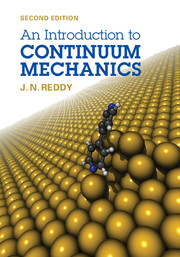Book contents
- Frontmatter
- Dedication
- Contents
- List of Symbols
- Preface to the Second Edition
- Preface to the First Edition
- About the Author
- 1 INTRODUCTION
- 2 VECTORS AND TENSORS
- 3 KINEMATICS OF CONTINUA
- 4 STRESS MEASURES
- 5 CONSERVATION AND BALANCE LAWS
- 6 CONSTITUTIVE EQUATIONS
- 7 LINEARIZED ELASTICITY
- 8 FLUID MECHANICS AND HEAT TRANSFER
- 9 LINEARIZED VISCOELASTICITY
- References for Additional Reading
- Answers to Selected Problems
- Index
2 - VECTORS AND TENSORS
Published online by Cambridge University Press: 05 July 2013
- Frontmatter
- Dedication
- Contents
- List of Symbols
- Preface to the Second Edition
- Preface to the First Edition
- About the Author
- 1 INTRODUCTION
- 2 VECTORS AND TENSORS
- 3 KINEMATICS OF CONTINUA
- 4 STRESS MEASURES
- 5 CONSERVATION AND BALANCE LAWS
- 6 CONSTITUTIVE EQUATIONS
- 7 LINEARIZED ELASTICITY
- 8 FLUID MECHANICS AND HEAT TRANSFER
- 9 LINEARIZED VISCOELASTICITY
- References for Additional Reading
- Answers to Selected Problems
- Index
Summary
A mathematical theory is not to be considered complete until you have made it so clear that you can explain it to the first man whom you meet on the street.
—David Hilbert (1862–1943)Background and Overview
In the mathematical description of equations governing a continuous medium, we derive relations between various quantities that characterize the stress and deformation of the continuum by means of the laws of nature (such as Newton's laws, balance of energy, and so on). As a means of expressing a natural law, a coordinate system in a chosen frame of reference is often introduced. The mathematical form of the law thus depends on the chosen coordinate system and may appear different in another type of coordinate system. The laws of nature, however, should be independent of the choice of the coordinate system, and we may seek to represent the law in a manner independent of the particular coordinate system. A way of doing this is provided by vector and tensor analysis. When vector notation is used, a particular coordinate system need not be introduced. Consequently, the use of vector notation in formulating natural laws leaves them invariant to coordinate transformations. A study of physical phenomena by means of vector equations often leads to a deeper understanding of the problem in addition to bringing simplicity and versatility into the analysis.
- Type
- Chapter
- Information
- An Introduction to Continuum Mechanics , pp. 9 - 80Publisher: Cambridge University PressPrint publication year: 2013



